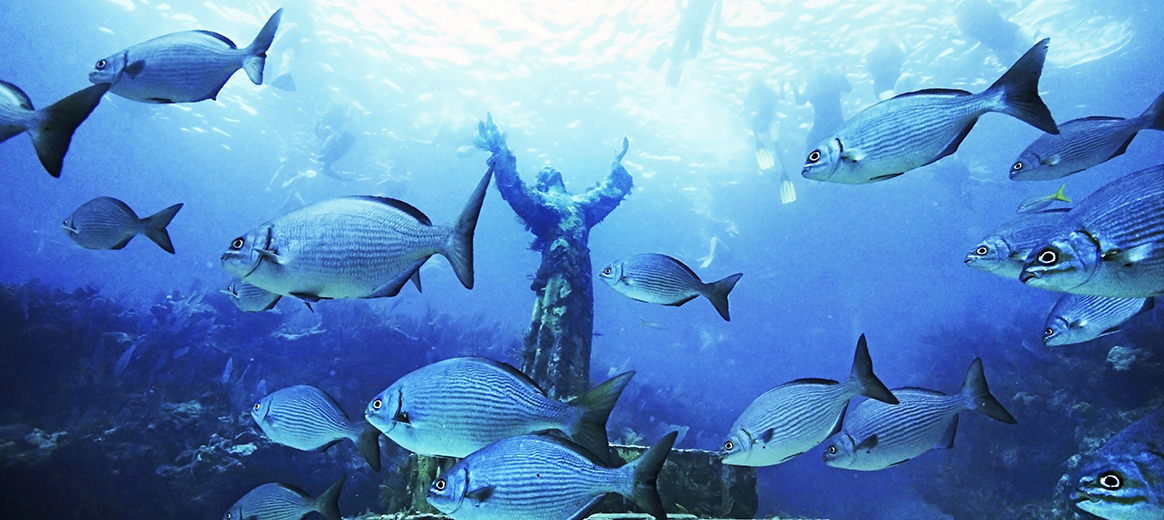VATICAN CITY — Imagine a pilgrimage where the faithful gear up
with scuba fins and oxygen tanks or snorkel sets rather than hiking boots, sun
hats and trek poles. That’s what happens in the crystal-clear waters of the
Paradise Gulf along the Italian Riviera near Genoa.
Pilgrimages to the bronze statue of Christ of
the Abyss, an 8-foot-tall sculpture submerged 56 feet below the surface of
the sea, were featured in the Vatican newspaper, L’Osservatore Romano, July 28.
The statue, located offshore halfway between the small
coastal villages of Camogli and Portofino, was the first
known statue of Christ to be placed in the sea as a sign of
his peace and protection for those who live, work or play by the water, to be a
place of prayer and to commemorate those who have died there.
According to Italian news, sports and tourism websites, the idea
came from Genoa-born Duilio Marcante, the so-called “father” of
underwater diving education. The statue’s home would be near where
Marcante’s friend, Dario Gonzatti, died during a dive in 1950. Gonzatti,
Marcante and Egidio Cressi created and tested the first prototypes of
“Self-Contained Oxygen Breathing Apparatus” (ARO) in those waters.
In 1952, Marcante proposed the idea of creating an underwater
“Christ of the Abyss” to Giacomino Costa, a Genovese
entrepreneur, shipowner and then-president of the Catholic Italian Sports
Center.
Costa asked Cardinal Giuseppe Siri of Genoa whether it would be
inappropriate to place a religious statue on the bottom of the sea.
The cardinal turned to Pope Pius XII for guidance. Not only did the pope
approve of the initiative, but he also sent a bronze medallion that would then
be mounted on the statue’s base. In 2014 Pope Francis sent a medallion
commemorating the 60th anniversary of the erection of the statue.
The Italian sculptor Guido Galletti created
the statue using more than 570 pounds of bronze, made up of metals
donated from all over the world: old bells, Olympic and war medals, coins, ship
fragments and even propellers from U.S. submarines.
The enormous statue was fixed to the sea floor Aug. 29,
1954. Galletti also made a small copy of the Christ statue for
Pope Paul VI in 1964 and, years later, Costa’s adult children found it had
ended up in the barracks of the Vatican’s fire department.
While scuba divers can visit the statue any time of
year — and many leave behind votives or rosaries — the parish of St. Fruttuoso
of Camogli and local diving groups pay tribute to the Christ of
the Abyss every last Saturday in July with a dive and prayers, a
candlelight procession and a Mass for those lost at sea. The COVID-19 pandemic
curtailed those celebrations the past two years, however.
Father Danilo Dellepiane of the Basilica di Santa Maria Assunta
in Camogli explained that the Christ of
the Abyss represents “the guardian of the sea” and recalls
“the certainty of the resurrection,” he told the Vatican newspaper,
L’Osservatore Romano, July 28.
“It is a symbol of Christ’s victory over every evil,
every struggle and all suffering,” he said.
An exact replica of Galletti’s statue — cast from the
same mold as the original — was made for the seabed off the shore of Key Largo,
Fla., in John Pennekamp Coral Reef State Park.
Numerous other renditions of Christ of
the Abyss are located underwater in lakes and oceans in many other
parts of the world.








Comments
Comments are disabled for this post.